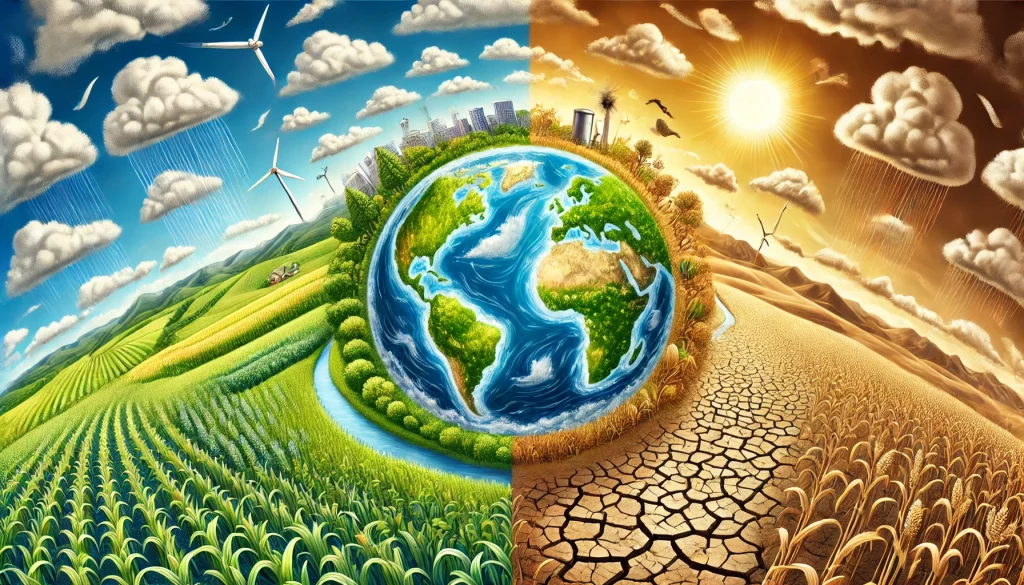
An in-depth look at how climate change & agriculture interact One of the most important issues of our day is climate change, which has profound effects on many industries, but especially agriculture. Food security and rural livelihoods are in danger due to the agricultural sector’s unprecedented challenges brought on by rising global temperatures & more unpredictable weather patterns. In addition to contributing significantly to greenhouse gas emissions, agriculture is also extremely vulnerable to changes in the climate.
Because of this dual function, it is essential to comprehend how agricultural practices are impacted by climate change & what steps can be taken to lessen those effects. Agriculture and climate change have a complicated and nuanced relationship. One way that agricultural practices impact climate change is through land-use changes, fertilizer emissions, and livestock emissions.
Conversely, the agricultural industry is susceptible to the effects of climate change, such as changed patterns of precipitation, a rise in the frequency of extreme weather events, & changes in the dynamics of pests. The demand for food will rise along with the world’s population, further taxing agricultural systems already under stress from climate variability. Developing successful plans to guarantee sustainable farming practices in a changing climate requires an understanding of this complex relationship. Among the most important effects of climate change on agriculture are changes in precipitation and temperature patterns.
In certain areas, longer growing seasons may result from rising global temperatures, which at first glance might seem advantageous for crop production. However, too much heat can also cause crops to experience heat stress, which lowers yields and degrades quality. Also, rising temperatures have the potential to throw off conventional planting and harvesting schedules, resulting in a mismatch between crop development stages and weather patterns. Farmers who depend on past weather trends to guide their agricultural decisions are at serious risk from this unpredictability. Climate change has an equal impact on precipitation patterns; some regions see longer droughts while others see more rainfall.
In certain areas, these changes may result in waterlogged soils that impede root development and encourage diseases, while in other regions, drought conditions may significantly restrict crop growth and yield. In addition to having an impact on crop yield, precipitation variability makes irrigation techniques more difficult because farmers must adjust to fluctuating water supplies. In order to create adaptive strategies that can lessen the negative effects of climate change on agriculture, it is imperative that these changes be understood.
For global food security, the effect of climate change on crop yields is a serious concern. According to research, staple crops like maize, rice, and wheat may yield less when temperatures rise. For example, research indicates that wheat yields may decrease by roughly 6% for every degree Celsius that the temperature rises.
Considering that these crops are essential to the world’s food systems, this decline is especially concerning. Crop nutritional quality can also be impacted by temperature & precipitation variations; for example, higher carbon dioxide levels may result in lower concentrations of vital nutrients like zinc, iron, & protein. Moreover, quality of crops includes aspects like taste, texture, and shelf life in addition to yield.
Because of its effects on plant physiology and biochemistry, climate change has the potential to change these quality parameters. Higher temperatures, for instance, may hasten the maturation of fruits & vegetables, producing less tasty produce. Extreme weather conditions like storms or droughts can also physically harm crops or cause spoiling losses after harvest. Farmers seeking to meet market expectations must comprehend how climate change impacts yield and quality as consumers grow more health-conscious & demand higher-quality produce. The dynamics of pests and diseases that impact crops are also being impacted by climate change. Many pests can now flourish in areas that were previously unsuitable for their survival due to warmer temperatures.
For example, it has been noted that insects like the corn earworm are migrating northward into regions where cooler temperatures previously prevented them from doing so. In addition to raising the possibility of crop damage, this change makes pest management more difficult for farmers who might not be prepared to handle these novel threats. It is anticipated that climate change will increase the prevalence of plant diseases in addition to pests. The proliferation of bacteria and fungi is facilitated by warmer temperatures & higher humidity levels. Diseases like rust or blight may become more common as a result, devastating crops if left unchecked.
More funding may be required for farmers to implement integrated pest management (IPM) techniques, which combine chemical treatments & biological control methods, as well as other pest & disease management strategies. In order to create resilient agricultural systems that can withstand the difficulties presented by climate change, it is imperative to comprehend these changes. Climate change is making the problem of water scarcity more urgent in many regions of the world.
Reduced water supplies are a result of altered precipitation patterns and higher evaporation rates brought on by warming temperatures, especially in arid and semi-arid areas where irrigation is crucial to agriculture. Maintaining crop production levels becomes increasingly difficult for farmers as water resources become more limited. Conflicts over water rights and usage are a result of the competition for water among domestic, industrial, and agricultural users. Adapting irrigation techniques to these shifting circumstances is necessary to guarantee sustainable agricultural output. Farmers are looking into more effective methods like drip irrigation and rainwater harvesting systems because traditional irrigation techniques might not be practical in regions with acute water shortages.
These techniques provide steady moisture levels during crucial growth times, which not only saves water but also increases crop resilience. To assist farmers in overcoming the obstacles presented by water scarcity, policymakers must fund infrastructure upgrades and offer training on sustainable water management techniques. Farmers must implement mitigation and adaptation plans suited to their unique situation in order to meet the challenges presented by climate change. Adaptation is modifying farming methods to increase resistance to the effects of climate change. This could entail adopting agroecological techniques that enhance soil health and biodiversity or broadening the crop varieties to include those that are more resilient to heat or drought. Farmers can increase their resilience to climate variability uncertainties while preserving productivity by implementing these tactics.
The goal of mitigation strategies is to lower greenhouse gas emissions from farming. Practices like better nutrient management, less tillage, and agroforestry systems—which store carbon in soil and vegetation—can help achieve this. Also, switching to organic farming practices can lessen dependency on artificial pesticides and fertilizers, which increase emissions. In order to combat climate change and ensure sustainable food production for future generations, farmers can play a critical role in incorporating both adaptation and mitigation strategies into their operations.
The way that agriculture and climate change interact has a big impact on the world’s food security. With crop yields falling as a result of climate change, there may be less food available, which could result in higher costs and possible shortages in areas that are already at risk. Supply chain interruptions brought on by severe weather events like hurricanes or floods, which can destroy vital infrastructure for moving food from producers to consumers, make the situation worse. Because the world’s food systems are interconnected, localized disruptions may have repercussions in other markets.
Also, food insecurity is frequently most noticeable in developing nations where resource scarcity & poverty are already placing a strain on agricultural systems. Investments in resilient food systems that can endure these shocks must be given top priority by governments and organizations as climate change continues to affect agricultural productivity. This entails strengthening regional capacities for food production, expanding smallholder farmers’ access to markets, & creating social safety nets that shield disadvantaged groups from the effects of fluctuations in food prices. Coordination of national & international policy initiatives is necessary to address the issues raised by climate change.
Governments need to create all-encompassing agricultural policies that encourage sustainable farming methods & help farmers adjust to shifting circumstances. This includes funding crop variety research and development for climate-resilient crops, offering financial rewards for environmentally friendly farming methods, and expanding access to technology that increases resource efficiency. In order to address the global nature of climate change’s effects on agriculture, international cooperation is equally essential.
Cooperation between nations can promote innovation through cooperative research projects and ease the exchange of best practices for mitigation and adaptation. Global frameworks like the Paris Agreement highlight how crucial it is to work together to address climate change issues in all sectors, including agriculture. By collaborating on sustainable farming methods, countries can increase their ability to withstand the effects of climate change while guaranteeing universal access to food.
In conclusion, there are many intricate issues at the nexus of climate change and agriculture that demand immediate attention from communities, farmers, and policymakers everywhere. Through comprehension of the complex effects of climate change on agricultural systems, such as modifications in temperature & precipitation patterns or adjustments in pest dynamics, stakeholders can create efficient adaptation & mitigation plans. Resilient agricultural systems that can sustain food production in an increasingly uncertain future can be developed through cooperative efforts at the local, national, and international levels.

